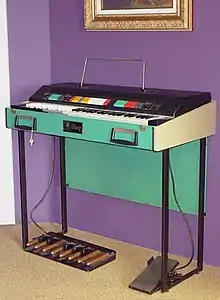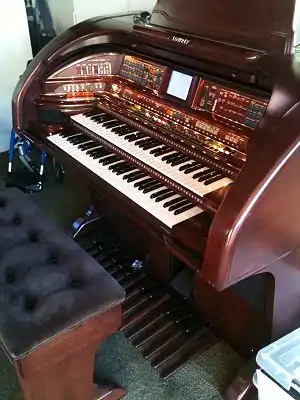Gibson G-101
The Gibson G-101, (or "Gibson Portable Organ"), is a transistorised combo organ, manufactured in the late 1960s by the Lowrey Organ Company in the late 1960s. It was also known as the Kalamazoo K-101. It provided a 61-key manual with a variety of stops accessed by rocker switches and a separate bass system.
| Gibson G101 | |
|---|---|
 | |
| Manufacturer | Gibson |
| Dates | 1967 - 1969[1] |
| Technical specifications | |
| Polyphony | Full |
| Synthesis type | Electronic |
| Input/output | |
| Keyboard | 61 keys |
Although not as successful as other combo organs such as the Vox Continental, it was used by a few popular musicians, particularly as the main organ for The Doors' Ray Manzarek.
Production
The instrument introduced by Gibson in 1967 but produced in the U.S. for them by the Lowrey Organ Company.[2] It was first introduced in 1966 as the Kalamazoo K-101, the name was changed to Gibson G-101 shortly thereafter, and production continued until 1969.[3]
Less than 2,000 models were produced, making the instrument a sought-after model for collectors compared to other combo organs.[3]
Dimensions and appearance
Despite the change in name badges and model numbers shortly after its introduction, the Kalamazoo K-101 and the Gibson G-101 are the same instrument.[3] It otherwise remained unchanged for its entire production run, from prototype to the last unit built. Gibson, which still makes service manuals available for the instrument, supplies only the G-101 manual.[4]
The instrument was 38" long, 20" front-to-back, 10" top-to-bottom of the cabinet (including the cover) and weighed 65 lbs. It had two square, tubular, fold-out legs, and a "drop panel" that acted both as support for the legs when standing (via thumb screws that secured the panel to tabs on the back of the legs) and also as a cover for the folded-in legs during transport. The bottom of the organ was recessed 2½" to accommodate the folded-in legs and allow room for the power supply; when standing, the organ is 40" tall (not including the detachable music rack).
The Gibson G-101's external features included a textured black plastic top, a tri-colored plastic keyboard (specifications detailed below), color-coded rocker-switch tabs, and a vinyl/fabric-covered plywood cabinet, drop panel, and lid, using an aqua-and-gray color scheme. It was a very sturdy and handsome-looking instrument. While superficially similar in appearance to many other combo organs in the 1960s, it can easily be distinguished from competing models (the Farfisa Compact and Vox Continental) by identifying the cabinet colors.[5]
Features
According to the service manual,[6] the G-101 had a single manual of five octaves (61 keys), which was divided into three sections:
- A bottom octave (13 keys, from "C1" to "C2") provided fixed bass, using reverse-colored white-on-black keys similar to those on the Vox Continental's entire keyboard to designate the area.
- A second octave (11 keys, from "C#2" to "B2"), could be configured either for "Extended Bass" or standard organ (treble) use, with white-on-gray keys to designate the area.
- Three octaves (37 keys, from "C3" to "C6") provided the main treble keyboard, using standard black-on-white keys.
The instrument offered the following controls across the cabinet top, listed from left to right:
- A rotary knob to control the volume of the bass section
- A bank of five tabs (color-coded) for voicings of the bass keys:
- (Green, 3) String Bass; Sax Bass; Fuzz Bass
- (Gray, 2) Bass Normal/Percuss.; Bass Sustain Off/On
- A rotary switch to select either 'extended bass' (On), or treble - lowest octave (Off), for the gray octave
- A bank of twelve tabs, (color-coded) for voicings on the treble keys:
Using these voicing tabs individually or mixing and matching them could produce dozens of distinct tones. Combining all of them would produce the signature "Gibson G-101" sound.
- A bank of eight tabs (color-coded) for signal processing on the treble keys:
- A rotary knob to control the Repeat Off/On/Rate
- The instrument's power switch with built-in pilot lamp
Accessories
Three optional accessories were available for the G-101: a travel bag, an expression pedal (volume pedal), and a set of bass pedals. The volume pedal had a spring-loaded side-lever that could be used to actuate the "Glide" and "Trumpet Wow-wow" effects. The 1/4" TRS jack also enabled users to connect a Gibson "Sabre" amp, or one of two external reverb units made by both Gibson and Maestro (which manufactured the Echoplex), as well as to any standard guitar or keyboard amplifier. The "Reverb" tab would be used to activate one of these. The G-101 had no onboard reverb unit. The instrument's top had a removable, fold-down wire rack for sheet music.
Sound
Because the G-101 was manufactured by Lowrey, its electronics - and thus, its voicings - are similar to Lowrey's own T-1 and T-2 models (all of which use the same generator boards as the Lowrey TLO ["Holiday"] spinet models); the G-101 is not, however, identical and does contain several additional distinctive features.[7]
The "Repeat" feature sounded similar to tremolo, but used a re-triggering circuit on the percussion board instead; the knob could be used to control its off/on and speed rate. This feature often faded in functionality because it used a "photo-cell" which contained a neon bulb that could dim over time, but this is fixable by locating and installing an appropriate replacement part.
The "Glide" effect pitched the notes flat by a half-step when actuated by the side-lever on the expression pedal when the "Glide" tab was selected to "Normal". This effect was used by organist Ray Manzarek of The Doors on the recording of "Not to Touch the Earth" (see quote below.) When the same tab was selected to "Trumpet Wow-wow", the side-lever would actuate a "wow-wow" type of effect. This feature also used a photo-cell which could fade over time, and was remedied the same way as "Repeat."
The "Piano" and "Harpsichord" tabs could be used to simulate the tones of those instruments. The tones could be given an abrupt, striking attack (note-onset time) when the "Percussion" and "Staccato" tabs were selected, producing a piano-like "bounce". The "Sustain" could be used on these latter two voices to leave a somewhat eerie jingling "after-ring" harmonic sound when the key was released.
A Lowrey organ, probably a Heritage Valve model, using the "Harpsichord" tab, was used by the Beatles to perform the opening measures of their song Lucy in the Sky With Diamonds. Because of its similarity to that model, the G-101 can be used to simulate that performance.[8][9]
Usage
Several major recording artists have used the Gibson G-101. The first was Ray Manzarek of The Doors, who switched from the Vox Continental to the G-101 during the recording of the Waiting for the Sun album, in 1968.[10] Manzarek later said the G-101 "had a little more versatility than the Vox; it could make the sort of piano-ish sound I used on "Back Door Man" (from The Doors album); plus, it had a little knob sticking up on the volume pedal which could bend the note a half-step down. We used it on "Not to Touch the Earth". Even synthesizers don't really do that."[10]
Jazz musician Sun Ra also began using the G-101 at some point during the 1960s. The first documented use is on the Atlantis album, which was released in 1969. Ra, who often invented names for his instruments, lists the G-101 as the "Solar Sound Organ" in the credits. Don Preston used a G-101 with Frank Zappa and the Mothers of Invention, and was seen playing one on the cover of his solo album Filters, Oscillators & Envelopes 1967-75.[10]
Steve Nieve, (a.k.a. Steve Nason) of Elvis Costello has told interviewers he also owns a G-101 and has used it on unspecified recordings.
References
Citations
- Lenhoff & Robertson 2019, pp. 195.
- Gibson G-101 information, Rodak
- Lenhoff & Robertson 2019, p. 202.
- Gibson manual, Rodak
- Photos of transistorized organs, Spyros Pantazis
- Feature information from manual, from Rodak
- Lenhoff & Robertson 2019, pp. 197,199.
- Lenhoff & Robertson 2019, p. 204.
- "LSD" performance, from Rodak
- Lenhoff & Robertson 2019, p. 196.
Sources
- Lenhoff, Alan; Robertson, David (2019). Classic Keys: Keyboard sounds that launched rock music. University of North Texas Press. ISBN 978-1-57441-776-0.
External links
- Gibson combo organs - Gibson/Lowrey data page at the Combo Organ Heaven website
- 1960s organs - 1960s music blog (includes image of organ and sound samples of Manzarek using the G-101 in concert)
- Sun Ra Instruments - Page on the organ (with images) from blog devoted to Sun Ra
- Lucy mp3 - MP3 file of the opening of "Lucy in the Sky With Diamonds" played on the Lowrey T-2
